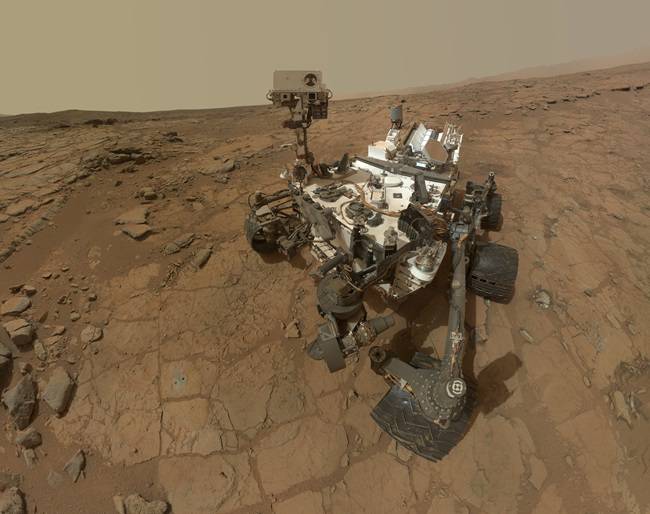This article is more than 1 year old
It's whiff, Jim, but not as we know it: Curiosity sniffs ORGANICS on Mars
But David Bowie still waiting for his answer
Two new papers on the latest data from the compact chemistry laboratory aboard nuclear-tank Curiosity show organic compounds in Mars' atmosphere and rocks – and therefore offer tantalizing clues to the Red Planet's watery past.
In the past 20 months Curiosity's Sample Analysis at Mars (SAM) laboratory has sniffed the air a dozen times using its mass spectrometer, gas chromatograph, and tunable laser spectrometer. As the rover has rolled across kilometres of Martian regolith the SAM instrument has sniffed four huge spikes in the methane content of the thin atmosphere – ten times the background reading – according to data published in Science.
The blasts of organic material, which were detected by SAM in late 2013 and early 2014, aren't necessarily proof of active organic life on Mars – it could be that they were formed by the action of water on Martian rocks' chemical contents.
"We will keep working on the puzzles these findings present," said John Grotzinger, Curiosity project scientist of the California Institute of Technology in Pasadena. "Can we learn more about the active chemistry causing such fluctuations in the amount of methane in the atmosphere? Can we choose rock targets where identifiable organics have been preserved?"
We've know of the presence of methane on Mars for nearly 20 years, but the variability of the readings suggests distinct pockets of the gas in a specific geographical location. What caused them is the million dollar question; the authors speculate it could be wind spreading the gas or multiple sources.
But the samples are a sign that organic materials on the planet persist, and they are not just in the air. In May last year Curiosity made its second drilling attempt and bored a six-centimetre hole in a rock formation dubbed Cumberland, and the resulting rock sample has yielded more organic evidence.
After months of analysis the NASA scientists concluded that some of the readings from the rock must have come from Earth-born contamination, but that the sample also clearly showed organic material that had originated on Mars, similar to chlorobenzenes found on Earth.
"This first confirmation of organic carbon in a rock on Mars holds much promise," said Curiosity participating scientist Roger Summons from MIT. "The challenge now is to find other rocks on Mount Sharp that might have different and more extensive inventories of organic compounds."

Curiosity selfie as it drills for water
A second Science paper details how Curiosity's lab has sampled some billion year-old Martian water molecules that show that life, if it could have existed, would have been around billions of years before mankind was even using tools, let alone sending one to a planet millions of miles away.
Drilling samples taken from Cumberland, and other low parts of robotic trundling-ground the Gale Crater, have been dated to between 3.9 billion to 4.6 billion years ago, yet still contain measurable amounts of water.
By measuring the amount of deuterium, a hydrogen isotope with an extra neutron, in water and measuring that against expected rates, the SAM results show that the water in the sedimentary rocks drilled came not from Mars' most moist period, but when much of the lighter H2O had escaped through the diminishing atmosphere.
"It's really interesting that our measurements from Curiosity of gases extracted from ancient rocks can tell us about loss of water from Mars," said Paul Mahaffy, SAM principal investigator of NASA's Goddard Space Flight Center and lead author on the paper.
So is there life on Mars? We don't know, nor if there ever has been. But the survey data from Curiosity does show that the precursors to life were, and are, present on our planetary neighbor. ®
